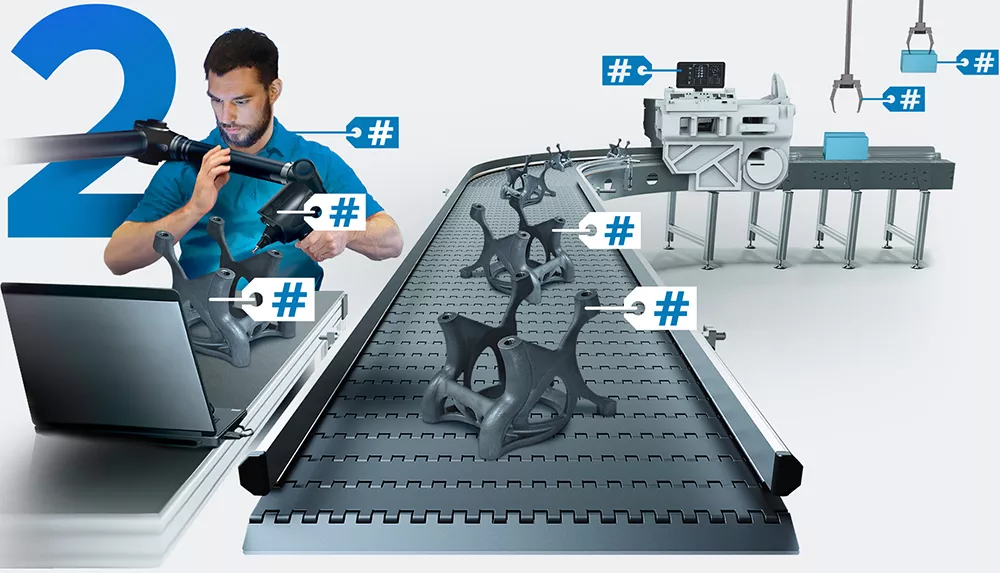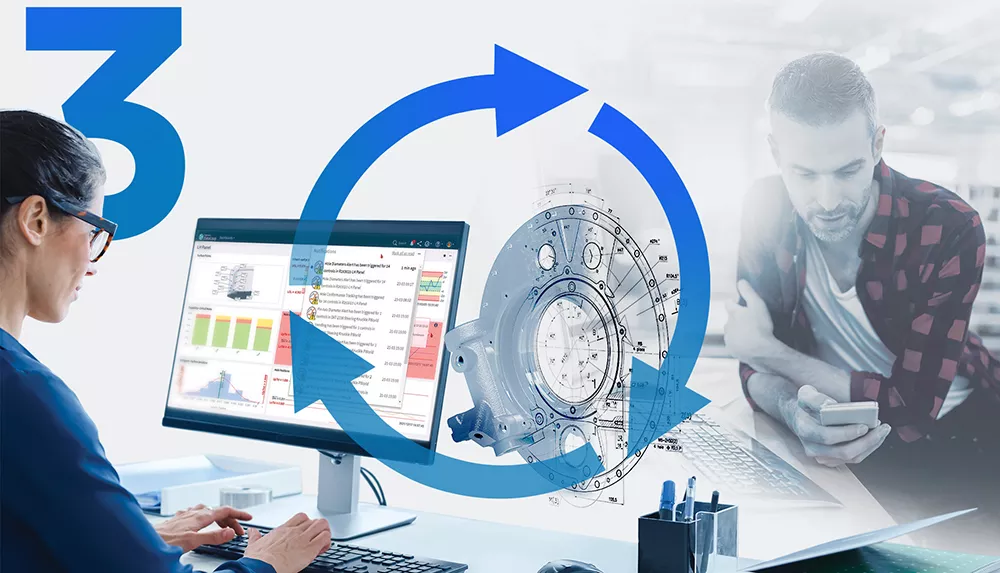
Data Management & Digital Connectivity
Increase the Value of your 3D Measurement Data
Data Management & Digital Connectivity
Increase the Value of your 3D Measurement Data
How implementing the right digital tools and processes empowers manufacturers to do so much more with their 3D measurement data.
The major innovations in 3D measurement hardware and software of the past 20 years have fueled the extensive growth of these technologies in manufacturing. In the product engineering phase, these technologies have reduced the number of prototypes and iterations needed to deliver functional manufacturing tools. In the pre-production phase, they help fine tune the product and accelerate the assembly process. In production, they make it possible to detect, analyze, and fix manufacturing issues. These benefits are no small matter.

Given the outstanding value that 3D measurement brings to engineering and manufacturing processes, it may surprise you to learn that 3D measurement processes have not significantly evolved in decades. They still rely on the manual exchange of files and folders. Indeed, inspection reports and projects are shared by manually copying them on network drives or sharing USB sticks. Even when a database is used to ease the sharing process, large monolithic files are uploaded on the system, thus making for slow data transfers. And slow data transfer makes for slower manufacturing.
Multiple manufacturing departments need 3D measurement data on a regular basis, but often the way they obtain this data is highly inefficient. While it does work, today there are other—and better—options. Could digital technologies help alleviate this issue and increase the value of 3D measurement data? In a word, yes.
Three steps to significantly increase the value of 3D measurement data


The first step should be setting up an enterprise-wide data management system for 3D measurement data
Why is this necessary? Because the first fundamental issue to resolve is access to data. The right data management system can remove roadblocks and speed up manufacturing overall.
And there are definitely roadblocks right now. Employees spend an average of 1.8 hours every day, or 9.3 hours per week, searching for and gathering information, according to a McKinsey report. In the quality realm, an InnovMetric survey of quality control operators found that on average they spend more than three hours every week finding, filing, and sharing inspection project files with colleagues. Sharing projects is a huge part of the workflow—in a typical high-volume manufacturing process, hundreds of inspection projects need to be managed and shared weekly.
A data management system makes 3D measurement data as accessible as your email inbox. It:
-
Automates file management
-
Ensures data security and integrity by centralizing data and enabling reliable backup strategies
-
Offers a search engine that makes it easy to find a 3D measurement project by typing keywords instead of browsing for files
-
Manages permissions to control who has access to the data and what can be done with it
To increase accessibility even further, many data management systems also offer access to data through web browsers and mobile apps. Imagine opening up a 3D measurement project on any platform from anywhere! The convenience of consumer technology meets 3D measurement at last. With this technology in place, it also becomes possible to integrate digital communication in manufacturing processes. For example, anyone in the organization can easily share 3D measurement data by e-mail or chat, allowing recipients to review data in a web browser in a single click.
By making it easy to share 3D measurement data and communicate via digital tools, a data management system improves product engineering, pre-production, and production, as it enables:
-
Quicker and possibly fewer iterations when solving a manufacturing issue
-
More efficient collaboration across departments
-
Easier collaboration with external suppliers
-
Real-time reactivity


The second step is implementing a metadata management strategy
Metadata is key process information about parts. It describes the design context (part number, drawing number, etc.), characterizes how a piece was fabricated (serial number, production line number, etc.), and describes how the piece was measured (operator name, device ID, etc.). Manufacturers should identify the information they want to store as metadata in the data management system and control its quality.
Metadata increases the performance of accessing 3D measurement data:
-
Rather than spending 5-15 minutes hunting down an inspection project, it would pop up after a 15- to 30-second search. Entering one or two details about a project, such as a serial number and a part number, allows users to quickly find the desired data on the first try.
-
Metadata is critical in root-cause analysis to identify and resolve manufacturing issues. For example, comparing the quality of parts produced by two suppliers is only possible if the measured pieces are associated with the right supplier.


The third step is to open up access to all users of the Product Lifecycle Management (PLM) system
PLM systems manage the entire lifecycle of a product by integrating data, processes, systems, and people and providing a product information infrastructure. With a data management system that provides stable URLs—i.e., specific addresses to a given resource on the web—it becomes possible to inject hyperlinks into the PLM items of single parts or assemblies, allowing PLM users to review 3D measurement data and results in a web browser in a single click.
Integrating 3D measurement data into digital PLM processes accelerates product development and proactively improves quality. For example, manufacturing engineers can use 3D measurement data to troubleshoot design and manufacturing issues, check on the success or failure of a fix, and document the causes of engineering changes. It is also possible to improve the efficiency of existing PLM-based approval processes by linking CAD revisions to their corresponding 3D measurement data. Finally, 3D measurement data could provide valuable input to designers to analyze the current manufacturing process in order to improve their next designs.

Why start a digital transformation with 3D measurement processes?
Implementing a data management system, a customized metadata strategy, and digital interconnectivity with the PLM system bring 3D measurement data to the heart of a manufacturer’s engineering and manufacturing processes. Here are four fundamental reasons why manufacturing organizations should consider 3D measurement processes as the ideal starting point for their digital transformation journey:

|
Build an initial success
|

|
Minimize business risks
|

|
Create a structuring framework
|

|
Increase data quality
|

Build an initial success
- Common sense says organizations should prioritize inexpensive projects with a quick ROI. Low-hanging fruit is always an easy sell. When implementing a 3D measurement data management system such as PolyWorks|DataLoop™ from InnovMetric, organizations quickly recoup their investment within weeks through significant productivity gains. Starting with an easy project that delivers tangible benefits and a great ROI is the safest way to mobilize employees for a successful digital transformation.

Minimize business risks
- Organizations can implement the three proposed digital transformation steps gradually, in multiple phases, as they are independent from each other, to minimize the disruptions on their operations and give ample time for their teams to build new digital skills.

Create a structuring framework
- The stable URLs delivered by the data management system enable content-rich digital communications, as teams can embed 3D measurement data within their messages to collaborate with colleagues.
- Access through web browsers, mobile devices, and PLM solutions ensure that anyone in the organization has 3D measurement information readily available – no matter which department they are in.

Increase data quality
- The availability of measurement results in 3D, rather than traditional 2D reports, makes it possible to drill down within information-rich 3D inspection projects to analyze dimensional issues from multiple perspectives.
- The availability of a digital twin for scanned pieces also makes it possible to add additional measurements on a single piece or multiple pieces to analyze problematic areas in more depth.
- The use of a data management system ensures that the latest project revision is always used.


The solution already exists!
Reliable and proven off-the-shelf solutions that deliver modern digital 3D measurement processes do exist. With its modern data management system for 3D measurement data, that allows centralizing 3D measurement data and makes easy data access a reality, the PolyWorks® digital ecosystem dramatically increases the value of 3D measurement data for manufacturing organizations.
Sharing data seamlessly is something that any organization needs. Manufacturers need 3D measurement data, and for best results, they need it quickly. The value of 3D measurement data increases the faster it arrives!